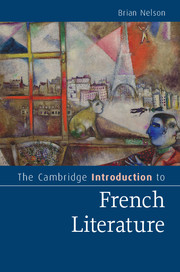Book contents
- Frontmatter
- Dedication
- Contents
- Preface
- Acknowledgements
- Chronology
- 1 Villon: a dying man
- 2 Rabelais: the uses of laughter
- 3 Montaigne: self-portrait
- 4 Corneille: heroes and kings
- 5 Racine: in the labyrinth
- 6 Molière: new forms of comedy
- 7 La Fontaine: the power of fables/fables of power
- 8 Madame de Lafayette: the birth of the modern novel
- 9 Voltaire: the case for tolerance
- 10 Rousseau: man of feeling
- 11 Diderot: the enlightened sceptic
- 12 Laclos: dangerous liaisons
- 13 Stendhal: the pursuit of happiness
- 14 Balzac: ‘All is true’
- 15 Hugo: the divine stenographer
- 16 Baudelaire: the streets of Paris
- 17 Flaubert: the narrator vanishes
- 18 Zola: the poetry of the real
- 19 Huysmans: against nature
- 20 Mallarmé: the magic of words
- 21 Rimbaud: somebody else
- 22 Proust: the self, time and art
- 23 Jarry: the art of provocation
- 24 Apollinaire: impresario of the new
- 25 Breton … Company: Surrealism
- 26 Céline: night journey
- 27 Sartre: writing in the world
- 28 Camus: a moral voice
- 29 Beckett: filling the silence
- 30 French literature into the twenty-first century
- Notes
- Further reading
- Index of authors and titles
- Index of genres, movements and concepts
- Cambridge Introductions to …
- References
19 - Huysmans: against nature
Published online by Cambridge University Press: 05 July 2015
- Frontmatter
- Dedication
- Contents
- Preface
- Acknowledgements
- Chronology
- 1 Villon: a dying man
- 2 Rabelais: the uses of laughter
- 3 Montaigne: self-portrait
- 4 Corneille: heroes and kings
- 5 Racine: in the labyrinth
- 6 Molière: new forms of comedy
- 7 La Fontaine: the power of fables/fables of power
- 8 Madame de Lafayette: the birth of the modern novel
- 9 Voltaire: the case for tolerance
- 10 Rousseau: man of feeling
- 11 Diderot: the enlightened sceptic
- 12 Laclos: dangerous liaisons
- 13 Stendhal: the pursuit of happiness
- 14 Balzac: ‘All is true’
- 15 Hugo: the divine stenographer
- 16 Baudelaire: the streets of Paris
- 17 Flaubert: the narrator vanishes
- 18 Zola: the poetry of the real
- 19 Huysmans: against nature
- 20 Mallarmé: the magic of words
- 21 Rimbaud: somebody else
- 22 Proust: the self, time and art
- 23 Jarry: the art of provocation
- 24 Apollinaire: impresario of the new
- 25 Breton … Company: Surrealism
- 26 Céline: night journey
- 27 Sartre: writing in the world
- 28 Camus: a moral voice
- 29 Beckett: filling the silence
- 30 French literature into the twenty-first century
- Notes
- Further reading
- Index of authors and titles
- Index of genres, movements and concepts
- Cambridge Introductions to …
- References
Summary
Against Nature fell like a meteorite into the literary fairground and there was astonishment and fury …
– Huysmans, Preface (1903) to Against NatureJoris-Karl Huysmans (1848–1907) began his literary career as a disciple of Zola, writing naturalist fiction: Marthe (Marthe, histoire d'une fille, 1876); The Vatard Sisters (Les Sœurs Vatard, 1879); ‘Knapsack’ (‘Sac au dos’ in Les Soirées de Médan, 1880); Living Together (En ménage, 1881). But the publication of Against Nature (À rebours, 1884) marked a deliberate break with naturalism, whose positivist assumptions Huysmans had come to find increasingly uncongenial. A startlingly original novel, Against Nature epitomizes Decadence, which was the dominant aesthetic of the fin-de-siècle. The novel's protagonist, a rich, neurotic aristocrat, the Duc Jean Floressas des Esseintes, seeks to escape from the mediocrity of contemporary society, the capitalist and consumerist society of the bourgeoisie, by withdrawing into a world of his own making, dedicated to realizing his private fantasies and pleasures. He attempts to create for himself an artificial paradise by living life ‘à rebours’ (‘back to front’ or ‘against nature’), thus carrying to the point of psychopathology the vision of his master, Baudelaire, who initiated the Decadent obsession with the artificial and the perverse, and argued that the aim of literature and art was not to imitate nature but to negate it.
The Decadent dandy
The Baudelairean flâneur, of which the dandy was the most flamboyant incarnation, attempts to avoid the ultimate terror of contemporary existence: ennui. The emergence of dandyism in France was a response to the rise of the bourgeoisie and the triumph of bourgeois culture. In a society that proclaimed the virtues of utility, work and thrift, the dandy rejected these values as vulgar. For Baudelaire, in ‘The Painter of Modern Life’, dandyism was an attempt to create a new aristocracy, not by reasserting the superiority of the upper classes over the lower classes, but by setting the individual against the common herd.
- Type
- Chapter
- Information
- The Cambridge Introduction to French Literature , pp. 141 - 146Publisher: Cambridge University PressPrint publication year: 2015

